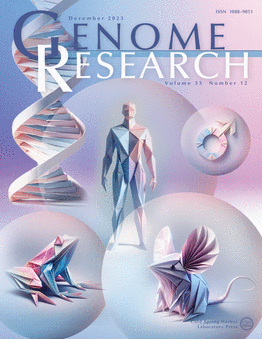Endonucleolytic cleavage is the primary mechanism of decay elicited by C. elegans nonsense-mediated mRNA decay
IF 5.5
2区 生物学
Q1 BIOCHEMISTRY & MOLECULAR BIOLOGY
引用次数: 0
Abstract
Premature stop codon–containing mRNAs can produce truncated and dominantly acting proteins that harm cells. Eukaryotic cells protect themselves by degrading such mRNAs via the nonsense-mediated mRNA decay (NMD) pathway. The precise reactions by which cells attack NMD-target mRNAs remain obscure, precluding a biochemical understanding of NMD and hampering therapeutic efforts to control NMD. Here, we modify and deploy single-molecule nanopore mRNA sequencing to clarify the route by which NMD targets are attacked in an animal. We obtain single-molecule measures of splicing isoform, cleavage state, and poly(A) tail length. We observe robust endonucleolytic cleavage of NMD targets in vivo that depends on the nuclease SMG-6. We show that NMD-target mRNAs experience deadenylation and decapping, similar to that of normal mRNAs. Furthermore, we show that a factor (SMG-5) that historically was ascribed a function in deadenylation and decapping is in fact required for SMG-6-mediated cleavage. Our results support a model in which NMD factors act in concert to degrade NMD targets in animals via an endonucleolytic cleavage near the stop codon, and we suggest that deadenylation and decapping are normal parts of mRNA (and NMD target) maturation and decay rather than unique facets of NMD.内溶核分裂是隐杆线虫无义介导的mRNA衰变引起的主要衰变机制
过早停止含密码子的mrna可以产生截短和显性作用的蛋白质,损害细胞。真核细胞通过无义介导的mRNA衰变(NMD)途径降解这些mRNA来保护自己。细胞攻击NMD靶mrna的确切反应仍然不清楚,这妨碍了对NMD的生化理解,并阻碍了控制NMD的治疗努力。在这里,我们修改和部署单分子纳米孔mRNA测序,以阐明NMD目标在动物中被攻击的途径。我们获得了剪接异构体、切割状态和poly(A)尾巴长度的单分子测量。我们观察到体内NMD靶标的强大的内核溶解裂解依赖于核酸酶SMG-6。我们发现nmd靶mrna经历死基化和脱帽,类似于正常mrna。此外,我们表明,一个因子(SMG-5)在历史上被认为在死基化和脱帽中起作用,实际上是smg -6介导的切割所必需的。我们的研究结果支持了一个模型,在这个模型中,NMD因子通过停止密码子附近的核内溶分裂协同作用来降解动物体内的NMD靶标,我们认为死基化和脱盖是mRNA(和NMD靶标)成熟和衰变的正常部分,而不是NMD的独特方面。
本文章由计算机程序翻译,如有差异,请以英文原文为准。
求助全文
约1分钟内获得全文
求助全文
来源期刊

Genome research
生物-生化与分子生物学
CiteScore
12.40
自引率
1.40%
发文量
140
审稿时长
6 months
期刊介绍:
Launched in 1995, Genome Research is an international, continuously published, peer-reviewed journal that focuses on research that provides novel insights into the genome biology of all organisms, including advances in genomic medicine.
Among the topics considered by the journal are genome structure and function, comparative genomics, molecular evolution, genome-scale quantitative and population genetics, proteomics, epigenomics, and systems biology. The journal also features exciting gene discoveries and reports of cutting-edge computational biology and high-throughput methodologies.
New data in these areas are published as research papers, or methods and resource reports that provide novel information on technologies or tools that will be of interest to a broad readership. Complete data sets are presented electronically on the journal''s web site where appropriate. The journal also provides Reviews, Perspectives, and Insight/Outlook articles, which present commentary on the latest advances published both here and elsewhere, placing such progress in its broader biological context.
 求助内容:
求助内容: 应助结果提醒方式:
应助结果提醒方式:


